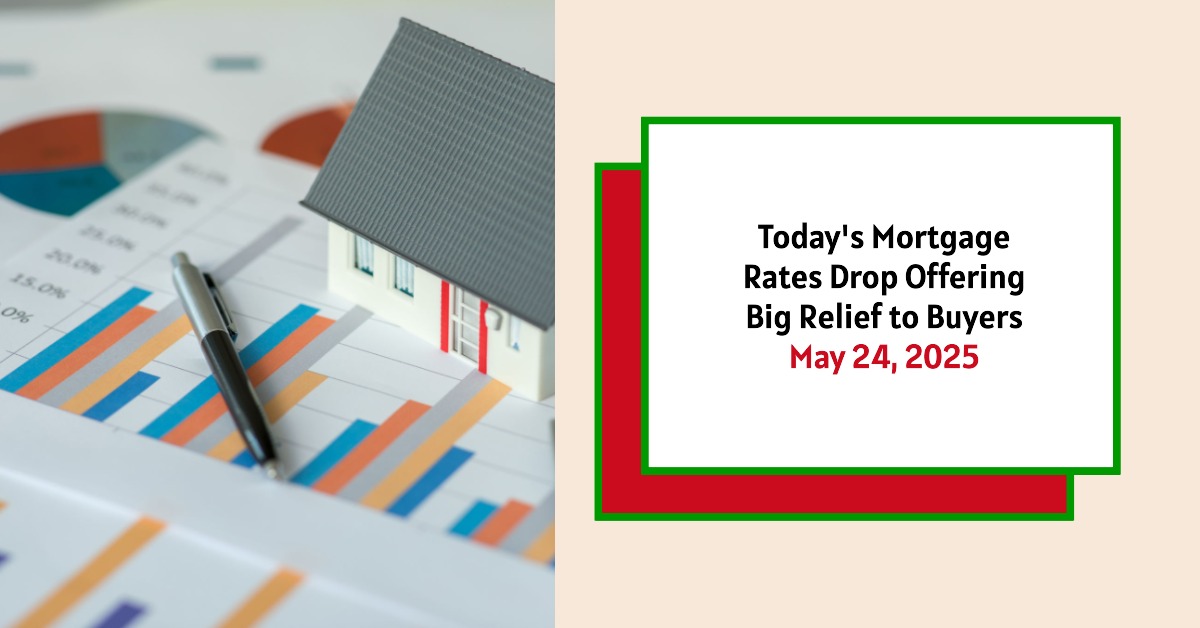As of May 24, 2025, mortgage rates have seen a slight drop after a brief period of increases. The national average for a 30-year fixed mortgage has decreased to 6.94% while the 15-year fixed mortgage rate is currently at 6.09%. This shift towards lower mortgage rates offers a bit of relief to potential homebuyers and those looking to refinance their existing mortgages.
Today's Mortgage & Refinance Rates – May 24, 2025: Rates Decline Giving Relief to Buyers
Key Takeaways:
- Current mortgage rates: 30-year fixed at 6.94%, 15-year fixed at 6.09%.
- Refinance rates: 30-year fixed refinance at 7.06%, 15-year fixed refinance at 6.15%.
- A brief uptick in rates was observed earlier this week before this surprising dip.
- Understanding market fluctuations is vital for both homebuyers and homeowners interested in refinancing.
Today's Mortgage Rates Overview
According to data from Zillow, the current mortgage rates are as follows:
| Mortgage Type | Current Rate (%) |
|---|---|
| 30-year fixed | 6.94 |
| 20-year fixed | 6.68 |
| 15-year fixed | 6.09 |
| 5/1 ARM | 7.35 |
| 7/1 ARM | 7.33 |
| 30-year VA | 6.41 |
| 15-year VA | 5.69 |
| 5/1 VA | 6.33 |
These rates reflect the national averages, rounded to the nearest hundredth.
Today's Mortgage Refinance Rates
For homeowners considering refinancing, the following rates are available:
| Refinance Type | Current Rate (%) |
|---|---|
| 30-year fixed | 7.06 |
| 20-year fixed | 6.84 |
| 15-year fixed | 6.15 |
| 5/1 ARM | 7.85 |
| 7/1 ARM | 7.39 |
| 30-year VA | 6.50 |
| 15-year VA | 5.91 |
| 5/1 VA | 6.26 |
Like mortgage rates, refinance rates are also expressed as national averages, indicating a slight difference compared to the rates for purchasing homes.
Understanding the Mortgage Rates Movement
The recent decrease in mortgage rates is somewhat surprising given the volatility observed in the bond market this week. Typically, when bond yields rise, mortgage rates tend to follow suit. However, the current trend offers a glimmer of hope as rates dip, albeit minimally. Mortgage interest rates are influenced by several factors, including the overall economic climate, inflation expectations, and Federal Reserve decisions regarding interest rates.
Experts point out that while the drop in rates is not substantial, it does indicate some easing in the momentum for higher rates. It can be beneficial for both prospective homebuyers and current homeowners contemplating refinancing options, fostering a more favorable borrowing environment.
What Drives Mortgage Rates?
Several critical factors influence mortgage rates, and understanding them can equip borrowers with the knowledge to make informed decisions:
- Economic Indicators: Inflation rates, employment data, and overall economic growth can lead to shifts in mortgage rates. For example, if inflation is higher than anticipated, investors may seek higher yields, affecting mortgage rates.
- Bond Market Dynamics: Since mortgages are often tied to the yield on 10-year Treasury notes, fluctuations in this market directly impact mortgage rates. A rise in Treasury yields typically leads to a corresponding increase in mortgage rates.
- Federal Reserve Policies: The Federal Reserve's decisions regarding interest rates and quantitative easing have significant effects on lending rates. For instance, if the Fed signals a tightening of monetary policy, mortgage rates may increase.
- Consumer Sentiment: Market perceptions can alter demand for loans, impacting overall rates. If consumers feel optimistic about the economy, they may be more inclined to take on loans, driving demand and potentially increasing rates.
Evaluating Fixed vs. Adjustable Mortgage Rates
When applying for a mortgage, borrowers often face the choice between a fixed-rate mortgage and an adjustable-rate mortgage (ARM). Each option has its pros and cons, which can be summarized as follows:
Fixed-rate Mortgages
- Pros: Payments remain consistent over time, allowing for predictable budgeting. Ideal for homeowners planning to stay in their homes long-term.
- Cons: Generally, fixed rates start off higher than the initial rate of an ARM, resulting in potentially higher monthly payments. This could be a disadvantage if the borrower plans to move within a few years.
Adjustable-rate Mortgages (ARMs)
- Pros: ARMs usually start with lower introductory rates, making initial payments lower than those of fixed-rate mortgages. This option may be suitable for those planning to move within the initial fixed period.
- Cons: After the initial period, rates can fluctuate based on market performance, leading to unpredictable payments that can pose a risk if rates rise.
Impact of Lower Rates on Home Buying and Refinancing Decisions
Lower mortgage rates can significantly influence home buying behavior. With rates now sitting below the 7% mark, it could incentivize both first-time buyers and those looking to upgrade or downsize to take action. Furthermore, for homeowners currently locked into higher interest loans, these new rates present a favorable opportunity for refinancing, potentially resulting in considerable long-term savings on interest payments.
For instance, if a homeowner with a $300,000 mortgage refinances from a 7.5% interest rate to the current 7.06%, the savings can be quite substantial. Over 30 years, this could translate into thousands of dollars in interest saved.
Forecasting the Future: Mortgage Rate Projections for 2025
As we continue through 2025, mortgage interest rates are expected to remain relatively stable. Experts project that they might hover in the mid-6% range rather than experiencing dramatic fluctuations. For example, Fannie Mae forecasts a potential drop to around 6.1% by the end of 2025, depending on economic developments.
Forecasts are inherently uncertain and influenced by various factors, including geopolitical events, domestic policies, and global economic conditions. If a recession occurs, it might lead to further declines in mortgage rates, giving opportunities for borrowers to secure favorable terms.
Moreover, analysts point toward home prices which have been experiencing an upward trend due to limited inventory. Fannie Mae anticipates prices to increase by 3.5% throughout 2025, which puts pressure on affordability for new homebuyers. This insight is critical since, while rates may drop slightly, home prices will continue to rise, potentially negating any savings from lower rates.
Market Sentiment and its Impact on Loan Decisions
Understanding how current market sentiment affects the housing market is also crucial for potential buyers and investors. The Federal Reserve's approach, especially concerning interest rates and its stance on inflation, plays a crucial role in shaping consumer confidence. As the cost of living continues to rise due to inflation, potential homebuyers may find themselves in a precarious position, weighing the urgency of securing a home against rising costs and interest rates.
Homebuyers must consider personal circumstances, such as job stability and long-term financial goals, which are essential elements in real estate decisions. If buyers find a property that meets their needs, the current rates may provide an advantageous opportunity.
Read More:
Mortgage Rates Trends as of May 23, 2025
Dave Ramsey Predicts Mortgage Rates Will Probably Drop Soon in 2025
Future of Mortgage Rates Post-Fed Decision: Will Rates Drop?
Fed's Decision Signals Mortgage Rates Won't Go Down Significantly
Mortgage Rates FAQs
What are the current mortgage rates?
As of May 24, 2025, the average 30-year fixed mortgage rate is 6.94%, with the 15-year fixed rate at 6.09%.
Are mortgage rates expected to decrease further?
While slight decreases have been observed, experts anticipate rates will remain fairly stable throughout the remainder of 2025.
How do I secure the best mortgage rate?
To improve chances of securing a low rate, focus on enhancing your credit score, reducing debt-to-income ratios, and exploring different loan types.
Should I refinance now or wait?
That decision hinges on your current interest rate, financial situation, and future plans. With the current rates dropping slightly, now may be an ethical moment to explore refinancing options, especially if it will lead to substantial savings.
Final Thoughts
With today’s mortgage rates exhibiting a minor downward trend, prospective buyers and existing homeowners should keep an eye on market shifts. Such changes, while sometimes minimal, can considerably impact financial decisions in the home buying and refinancing processes. While current rates offer a glimmer of relief, their movements remain influenced by broader economic factors that are complex and multifaceted.
For those looking in the housing market, the most important takeaway is to align personal circumstances with market conditions. Timing the market can be challenging, but understanding the implications of current trends can allow buyers to make empowered decisions.
Invest Smarter in a High-Rate Environment
With mortgage rates remaining elevated this year, it's more important than ever to focus on cash-flowing investment properties in strong rental markets.
Norada helps investors like you identify turnkey real estate deals that deliver predictable returns—even when borrowing costs are high.
HOT NEW LISTINGS JUST ADDED!
Connect with a Norada investment counselor today (No Obligation):
(800) 611-3060
Also Read:
- Will Mortgage Rates Go Down in 2025: Morgan Stanley's Forecast
- Expect High Mortgage Rates Until 2026: Fannie Mae's 2-Year Forecast
- Mortgage Rate Predictions 2025 from 4 Leading Housing Experts
- Mortgage Rates Forecast for the Next 3 Years: 2025 to 2027
- 30-Year Mortgage Rate Forecast for the Next 5 Years
- 15-Year Mortgage Rate Forecast for the Next 5 Years
- Why Are Mortgage Rates Going Up in 2025: Will Rates Drop?
- Why Are Mortgage Rates So High and Predictions for 2025
- Will Mortgage Rates Ever Be 3% Again in the Future?
- Mortgage Rates Predictions for Next 2 Years
- Mortgage Rate Predictions for Next 5 Years
- Mortgage Rate Predictions: Why 2% and 3% Rates are Out of Reach
- How Lower Mortgage Rates Can Save You Thousands?
- How to Get a Low Mortgage Interest Rate?
- Will Mortgage Rates Ever Be 4% Again?



